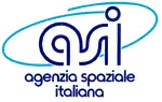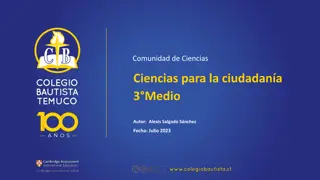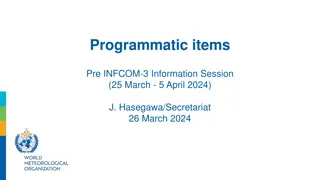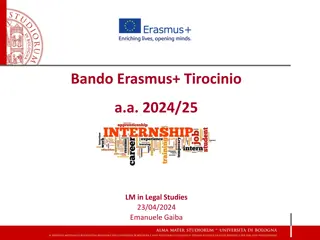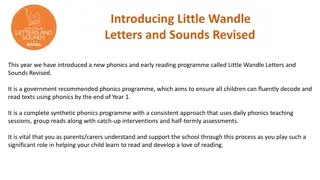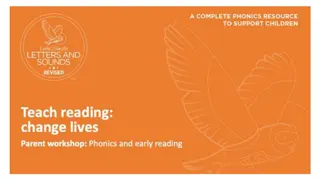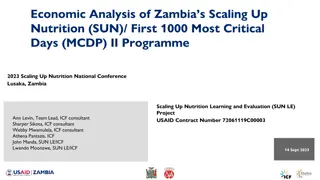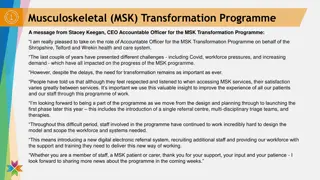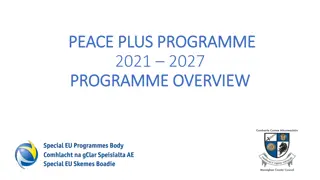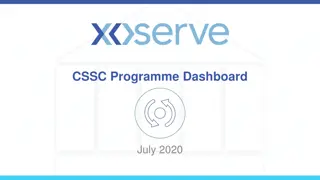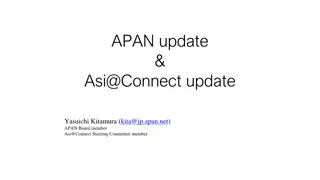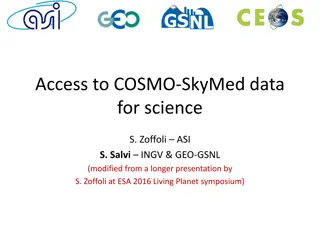ASI Science Programme
Programme led by Barbara Negri at the Italian Space Agency (ASI), focusing on solar system exploration, cosmology, high-energy astrophysics. ASI is involved in various space missions and collaborations with institutes and agencies.
Download Presentation

Please find below an Image/Link to download the presentation.
The content on the website is provided AS IS for your information and personal use only. It may not be sold, licensed, or shared on other websites without obtaining consent from the author. Download presentation by click this link. If you encounter any issues during the download, it is possible that the publisher has removed the file from their server.
E N D
Presentation Transcript
ASI Science Programme Barbara Negri - Italian Space Agency (ASI) Head of Exploration and Observation of the Universe Department 10 Years of PAMELA
Observing the Universe Activities of ASI s Department for the Exploration and Observation of the Universe (EOS) are organized into three main lines: Exploration of the Solar System (heliophysics, planetology of the Solar System and exo-planets) Cosmology and Fundamental Physics (general relativity, theory of gravitation, universe on a large scale and early universe) High Energy Astrophysics (astrophysics and astroparticles) Scientific activities are carried out in collaboration with the National Institute for Astrophysics (INAF), the National Institute for Nuclear Physics (INFN), the National Research Council (CNR) and a number of Universities. ASI has launched national scientific satellites and participated in major missions by ESA, NASA and other agencies (JAXA, Roscosmos, etc.) 2 17-
ASI involvement in Science Space Programme ASI involvement in space programs can be grouped as follows: - ESA Scientific Programme: Cosmic Vision 2015-2025 (mandatory Science Programme): Not mandatory programme: ExoMars Programme: - ExoMars 2016 (launch: 16 March 2016) - ExoMars 2018 (launch: 2020) - Programs in cooperation with other agencies (NASA, JAXA, Roscosmos, etc ...) - Missions In Operation (Planetary, Astrophysics, Astroparticles) - National scientific satellites in orbit: AGILE and LARES 3 17-
ESA Scientific Programme building blocks 4 COSMIC VISION 2015-2025 Large missions, L Medium missions, M Small missions, S Opportunity missions, O (previously known as cooperative) Missions in operation Basic activities a. Preparation for the future b. Technology development 1. 2. 3. 4. 5. 6.
ESA programs, I 5 Horizon 2000+ Cornerstone: GAIA, advanced astrometry, adopted: 2000; launched Dec. 2013. Cosmic Vision: BEPI-COLOMBO, mission to Mercury, approved in 2007; target launch: Mar. 2017. M1: SOLAR ORBITER, adopted: Oct. 2011; launch Oct. 2018. M2: EUCLID, adopted: June 2012; target launch: Dec.2020. M3: PLATO extrasolar planet search, selected Feb. 2014; target launch: 2024. M4: ARIEL, THOR, XIPE, selection June of 2017 S1: CHEOPS Exoplanets, adopted: Jun. 2014; launch Jul. 2018 M5: call issued April 29, 2016
ESA programs, II 6 L1: JUICE, JUpiter Icy moon Explorer, selected: May 2012, target launch: 2022. L2: ATHENA, Advanced Telescope for High-Energy Astrophysics, selected: June 2014, target launch: 2028. L3: eLISA Gravitational Wave Observatory
S ome major steps in A S I S cience P rogramme S ome major steps in A S I S cience P rogramme 2 007 A gile 2 007 A gile 2 005 M R O 2 005 M R O 2 006 2 006 P A M E L A P A M E L A 2 004 R O S E T T A 2 004 2 007 2 007 D A W N R O S E T T A D A W N 2 004 S W IF T 2 004 S W IF T 1 9 9 7 C assini H uygens 1 9 9 7 H uygens C assini- - 2 003 2 003 M ars E xpress M ars E xpress 1 9 9 6 B eppo 1 9 9 6 B eppo- -S A X S A X 1 9 9 2 L ageos2 1 9 9 2 L ageos2
S ome major steps in A S I S cience P rogramme S ome major steps in A S I S cience P rogramme 300px-LAGEOS-NASA 2 01 3 2 01 3 G A IA G A IA 2 01 5 P F 2 01 5 L isa P F L isa- - 2 01 1 J uno A M S 2 01 1 J uno A M S 2 01 2 L ares N U S tar 2 01 2 L ares on V ega N U S tar on V ega 2 008 F ermi 2 008 F ermi 2 009 H erschel P lanck 2 009 H erschel P lanck
R emote sensing P ayloads R emote sensing P ayloads Imaging S pectrometer C assini D awn R osetta J uno V enus E xpress Imaging S pectrometer C assini D awn R osetta J uno V enus E xpress C ameras E xomars R osetta C ameras E xomars R osetta Agenzia Spaziale Italiana S A R R adar C assini S A R R adar C assini O ptical suite B epiC olombo O ptical suite B epiC olombo S ounding radar M ars E xpress M R O S ounding radar M ars E xpress M R O R adioscience C assini J uno B epicolombo R adioscience C assini J uno B epicolombo Padua January 2010
A strophisycs A strophisycs and C osmology missions and C osmology missions X M M Integral F ermi X M M Integral F ermi A G IL E A G IL E H erschel H erschel P amela P amela 300px-LAGEOS-NASA P lanck P lanck N u- -S tar N u S tar A M S A M S - -2 2
In situ instruments In situ instruments P hilae P hilae H H - -A S I A S I Agenzia Spaziale Italiana S D S D 2 2 D R E A M S D R E A M S M A M A - -M IS S M IS S
2020 Mission 2016 Mission Trace Gas Orbiter (TGO) Carrier & Descent Module EDL Demonstrator Module (EDM) Rover + Landed Platform Proton Proton ExoMars Programme: - The first mission, launched on March 14th 2016, will land on Mars on October 19th - The second mission wil be launched on 2020
ASI has been involved since long time in the space missions dedicated to cosmic rays studies. Before PAMELA, ASI funded NINA1 and NINA2. PAMELA 2006 AMS 2011 CALET 2015
Payload for Antimatter Matter Exploration and Light Nuclei Astrophysics Italian contribution to PAMELA up to about 5.5 Meuro since beginning, funding about 8 italian Institutes and: science Mission Control Data taking from RESURS DK satellite Data analysis Public Outreach Search for dark matter annihilation, antihelium (primordial antimatter), new Matter in the Universe (Strangelets?) Study of cosmic-ray propagation, solar physics and solar terrestrial magnetosphere, high energy electron spectrum (local sources?) modulation,
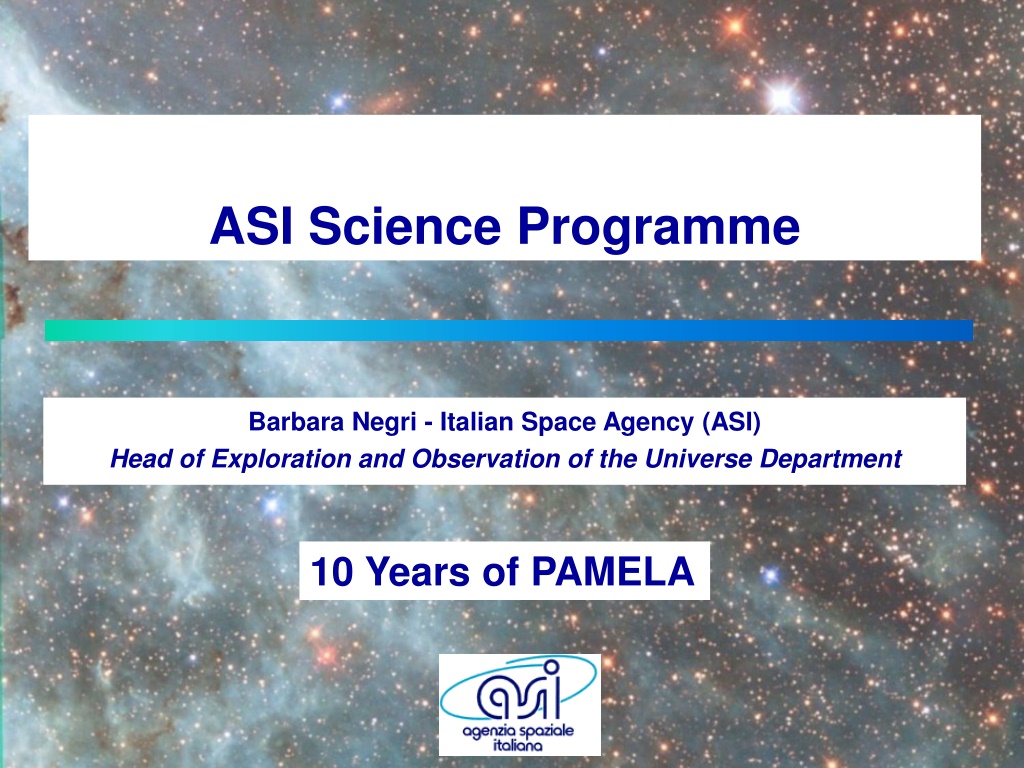
 undefined
undefined


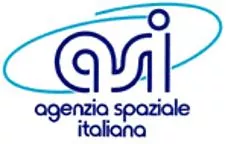

 undefined
undefined



